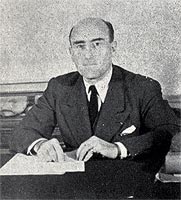
 Raymond Templier, the son, grandson, and great-grandson of jewelers, was born in Paris on April 22, 1891. He attended the École Nationale Supérieure des Arts Décoratifs from 1909 to 1912, and as early as 1911, he exhibited at the Salon des Artistes Décorateurs and later participated in the Salons d'Automne and des Tuileries.
Raymond Templier, the son, grandson, and great-grandson of jewelers, was born in Paris on April 22, 1891. He attended the École Nationale Supérieure des Arts Décoratifs from 1909 to 1912, and as early as 1911, he exhibited at the Salon des Artistes Décorateurs and later participated in the Salons d'Automne and des Tuileries.
In 1929, he co-founded the Union des Artistes Modernes (U.A.M.) with René Herbst, Robert Mallet Stevens, Puiforcat, Hélène Henry, and Pierre Chareau. He also played a significant role in the International Exhibitions of 1925 and 1937 in Paris.
Raymond Templier held the position of vice-president of the Salon d'Automne for the Decorative Arts and was a member of the Council for Higher Education in the Decorative Arts and the Council of the Chamber of Syndicate of Jewelry, Jewelers, and Goldsmiths. He was an Expert for the First Instance Court. Alongside his essential work as a jewelry designer and creator, he also produced various objects related to sports, including boxing belts commissioned by "Auto" and "Les Sports" journal in Brussels, swimming, basketball, skiing, and golf trophies for His Excellency Glaoui, as well as posters for the Tennis Federation.
Raymond Templier's works can be found in the Museums of Modern Art and Decorative Arts in Paris, as well as the Metropolitan Museum in New York. He has been a Chevalier of the Legion of Honor since 1938. As a jewelry designer, Raymond Templier was one of the first to give jewelry, especially more than other objects subject to fashion fluctuations, a style with rigorous principles, yet not devoid of fantasy and sensitivity, which are essential for a significant element of feminine adornment. He was ahead of his time, and his involvement as a jeweler in founding the U.A.M. was a victory for jewelry and an artistic stance to which he remained loyal.
For Raymond Templier, no matter how small, the jewel, conceived as a volume in space, resembles a sculpture. The laws that govern its construction are as absolute as those adhered to by an architect, sculptor, or musician.
"The composition of a jewel must be both free, dynamic, and condensed, enclosed," explains Raymond Templier. There should be no gratuitous or superfluous elements in rhythms that interact with light. Precious stones are never randomly placed for their own brilliance, but they are arranged at critical points where they, in relation to curves, coils, contours, and volutes, express themselves both sensibly and aesthetically.
Free from any anachronistic repertoire, Raymond Templier derives his themes, stripped of unnecessary ornamentation, from the aesthetic language of his rich time, which, for those who understand it, offers inexhaustible decorative resources. This innovative concept of jewelry led the artist to engage in the realm of objects destined for sports competitions, treated as sculptures and crafted from silver and stainless steel.
These objects are reduced to skillful plays of volumes and lines that exalt the victorious athlete's gesture in bold schematism. Thus, Raymond Templier, expanding the scope of his research, opposes the mundane and anonymous cup with a living, contemporary, and explicit symbol—an authentic work of art.
Sources : Mobilier et Decoration N°1 de 1954